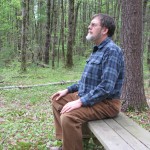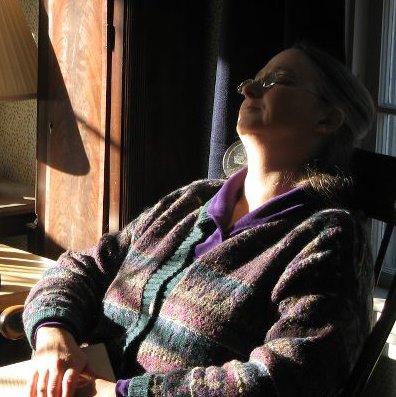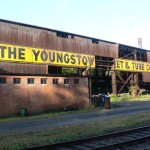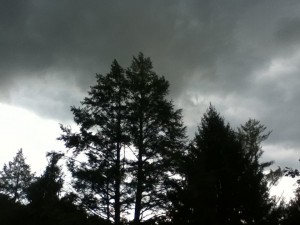
Our hemlock tree is dying.
Seventy feet tall or more, its feathery top boughs filter the light below. Its triple trunk, hard roots, and burnished needles dominate the yard. It cradles the altar Peter shaped to fit its branches.
We have celebrated Lammas beneath this tree, watched its branches snare the moon, and carefully skirted the faerie ring at its feet.
World Tree, Tree of Life, stubborn, strong, it shelters hundred wild creatures. Our hemlock tree is sacred. And it is dying, in spite of anything we can do.
Two summers ago, my husband moved his parents to live in the house next door. Their home in Ohio had become too hard to manage, and it was clear that Peter’s father’s dementia was worsening.
We hoped that moving them across the country to live next door would improve their quality of life. We didn’t reckon on how much their moving here would improve our own. New traditions sprang up for all of us: Friday nights are for pizza and Star Trek at our house; Saturdays are for my mother-in-law’s home cooking and Downton Abbey. And any night of the week, if I have extra pasta or leftovers on hand, we invite them over, and they come. We go to movies together, and Peter has set up a workshop in their basement, which also houses their enormous collection of vintage science fiction novels.
We are in and out of one another’s houses every day, and it turns out we all like it that way. Our jobs are demanding and time is short, but we enjoy just being together, hanging out as friends.
Our hemlock tree has been dying as long as we have lived in this house. Imperceptibly at first, and then aggressively, Wooly adelgids—minute, wax-cocooned insects that suck the chlorophyll from trees—have leached the life from twig and branch and bough. Drifts of yellow needles fall each year, and though they are replaced with new ones, every spring fewer living branches remain. Every year, we cut away more of the dying branches, and every year the lichen shrouds a little more of the bark.
For the first few years we lived here, dead lower branches snatched like bony fingers if we tried to walk beneath. Now, I stand beneath the tree and look unobstructed up into the green.
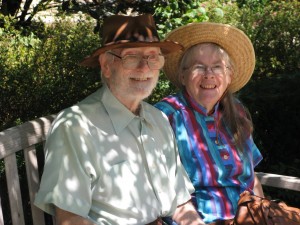
I have to stretch on tiptoe, to reach those fingers now.
I have always liked my mother-in-law, but I only figured out recently how much. I like that being together makes her happy, and I’ve never seen her look so happy and relaxed as she has the last few months. We enjoy each other, and life is good.
Life is good, and that’s still true, although this summer we learned that she has cancer. It’s true despite the fact that Peter’s father, a college professor who once coached Peter on the esoterica of physics and chemistry, can no longer easily read a menu.
It’s true, despite the fact that, like that last, perfect tranquil day in autumn, we are all aware: the beauty of this season cannot last.
Peter’s mom is dying. Peter is grieving. His father is confused, and every day more helpless. And we are all well, and our lives today are good. We smile often…though sometimes, of course, we cry.
We have tried to save our hemlock tree. We brought in arborists, and found an expert who gave us poisons to permeate the tree. In theory, we might have killed those tiny killers, those adelgids, and left the life of the tree unharmed.
We did our best. The first year, we told ourselves that fewer needles were turning yellow, that fewer branches fell.
The next year, however, again, the needles fell in golden drifts, and woodpeckers appeared more often on the trunk, far up above the ground.
In August, Peter’s mother was briefly hospitalized. And in the back and forth between our home and their home and the hospital we began to understand that without his wife, his father could no longer live alone. We have begun to plan for what comes next.
Even in its dying, our hemlock tree is beautiful. Cardinals and resting hawks visit. Squirrels and chipmunks chase one another in and under our tree, and on one memorable day last spring, two hungry bear cubs spent hours clambering up and down.
Our hemlock tree is home to wonders, even now.
Two weeks ago, we toured assisted living centers near us. Peter’s father is wait-listed now, at a place we think he’ll thrive. Two days ago, we met again for pizza and TV, and last night, we all ate dinner out. If Peter’s father needed help to use a credit card, still he was proud to treat us, and his prime rib was very good. He ate it all.
This afternoon, we’re going to the movies. We’ll watch Star Wars; Ed remembers Star Wars, and so do we.
Our hemlock tree is dying.
And so are we. And yet, our lives are good.
AFTERWARD
This post was written in early January. Since then, the perfect autumn day of our family life has passed, and winter has arrived.
Shortly after I wrote this post, my mother-in-law was hospitalized with a systemic infection, probably a side effect of her chemotherapy. Despite antibiotics and IVs, one by one, her body’s systems shut down, and she decided it was time to move to palliative care only. At that point, she was not expected to live more than a day or two at best, so Peter and I began scurrying between work and home and the hospital and Peter’s parents’ house next door, trying to arrange finances and care and dinners for his dad.
We were blessed. A unit in assisted living opened up, and both Peter’s dad and his cat have made the move to their new home. And then, against all expectation, Sheila’s condition also stabilized. For the past week, she has been out of ICU and in a nursing home, but even better, with help from hospice and the assisted living facility, we hope to transfer her to Ed’s unit by the end of this week, so that she will die at home, with her husband of almost sixty years.
Life is an uncertain business, and mortality is the price we pay for admission. So much of Pagan wisdom is about reconciling us to those truths… And while I can’t say I actually accept death, at least when it comes to people I love, I am grateful for the time together we have had.
No life, no season, lasts forever. But we can embrace the time we have.
Blessed be.
February, 2017.

